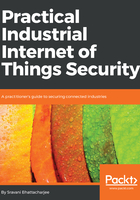
Functional viewpoint
The functional viewpoint provides a basic abstraction to design the important functional components of an IIoT end-to-end architecture. IIoT involves multiple mission-critical functional components with complex structures, mutual interactions, interfaces, and connectivity. These need to be properly designed to ensure safety and resilience.
IIRA decomposes this functional viewpoint into five function domains to better tackle analysis, design, and security integration. These functional domains are applicable across industry verticals. While there can be other ways to decompose function-specific use cases, the following five domains provide a starting point to conceptualize a functional architecture:
- Control domain: This focuses on the sensing and actuator functions. Interaction with external physical objects and the environment is the main aspect of this domain, which also deals with environmental safety, resilience, and data protection. Common examples are control units in a wind turbine or autonomous vehicle, or an ICS in an energy grid.
- Operations domain: In an industrial internet architecture, traditional industrial controls which are typically focused on one local physical plant, evolves to a higher level. The operations domain includes functions around provisioning, management, monitoring, and optimization across multiple plants, asset types, fleets, or customers. As an example, instead of optimizing one train, IIoT operation domain factors in data combined from multiple fleets owned by different railroads. This can optimize the rail network utilization across an entire country.
- Information domain: Represents a collection of functions to gather data from various domains, most significantly from the control domain. This data is then transformed, persisted, and modeled to acquire high-level intelligence about the overall system; which in turn helps us obtain data-driven insights and dynamic optimization. For example, using cost, demand, and logistics, the output of an automated production plant can be dynamically altered. Since these functions mostly belong to the IT domain, proper cybersecurity controls must be integrated in the planning and in design.
- Application domain: This includes functions to implement business functionalities, such as application logic and rules, APIs, dashboards, and so on.
- Business domain: Functions integrate the IIoT systems with traditional or new business applications such as ERP, CRM, Product Lifecycle Management (PLM), Manufacturing Execution System (MES), Human Resource Management (HRM), asset management, service lifecycle management, billing and payment, work planning and scheduling systems, and so on.
These functional domains cross-cuts multiple system trustworthiness characteristics, as shown in Figure 2.8. Depending on the specific use case requirements, these functional domains can be concentrated or dispersed, both logically and physically. For example, the information domain can be provisioned either at the edge of the industrial premises (for faster processing and decisioning), or in remote data centers or with cloud service providers:
